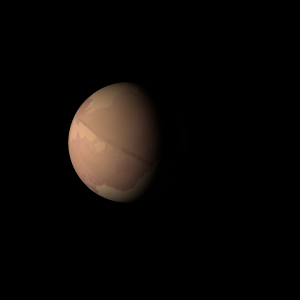|
|
Space Astro
|
Info for exoplanet "Tiqux-uvaha"
| Scientific (actual) data |
|---|
| Name | Kepler-321 c |
| Planet status | Confirmed |
| Radius | 0.207 |
| Orbital period | 13.0939 |
| Semi major axis | 0.11 |
| Discovered | 2014 |
| Updated | 2021-02-05 |
| Tconj | 2454980 |
| Impact parameter | 0.01 |
| Publication | Announced on a website |
| Detection type | Primary Transit |
| Alternate names | 2MASS J19374888+4408447 c, K01809.01, KIC 8240797 c, KOI-1809 c, KOI-1809.01, WISE J193748.89+440844.8 c |
| Star name | Kepler-321 |
| Right ascension | 294.45° |
| Declination | 44.15° |
| Mag j | 11.621 |
| Mag h | 11.3 |
| Mag k | 11.249 |
| Star distance | 388.83 |
| Star mass | 1.01 |
| Star radius | 1.19 |
| Star temperature | 5740 |
| Star alternate names | 2MASS J19374888+4408447, KIC 8240797, KOI-1809, WISE J193748.89+440844.8 |
| Wikipedia article | Kepler-321 c |
Back
| |
| Fictional info (?) |
|---|
| Suggested name | Tiqux-uvaha |
| Planet type | Terrestrial |
| Having almost no atmosphere to retain heat, it has surface temperatures that vary diurnally more than on any other planet in its solar system, ranging from 165°K (-108°C) at night to 875°K (602°C) during the day across the equatorial regions.
It has the densest atmosphere of the terrestrials, consisting partly of oxygen. It may have had carbon dioxide oceans in the past, but these would have vaporized as the temperature rose due to a runaway greenhouse effect.
It has been deemed sacred by members of many civilizations, and has been a prime inspiration for poets, calling it the "morning star".
The two polar ice caps appear to be made largely of dust.
The largest moon is crawling with unpredictable but interesting bacteria, the "Ytyx Osoh-of", which survive scattered in groups by devouring the Riginylo plant. Most Ytyx Osoh-of are related to Kunef-iru and have 5 eyes and vary in length from 40 to 80 meters. Most Ytyx Osoh-of are known to withstand temperatures from -20 to 0°C and intense weather which is common on Tiqux-uvaha. |
| Estimated population | 2100000000 |
| Atmosphere | Oxygen | 95% |
| Methane | 4.5% |
| Carbon dioxide | 0.026% |
| Water | 1.0E-6% |
| Atmospheric pressure | 0.009 bar |
 |
| Moon | Hufib | Medium-sized irregular crater-filled comet |
| Google search for Tiqux-uvaha |
|
Website by Joachim Michaelis
|
|
|
|